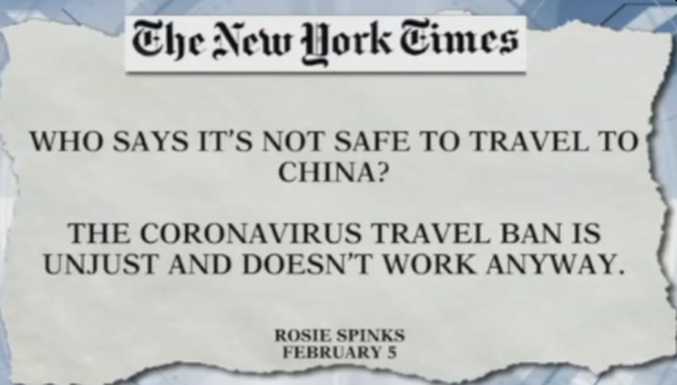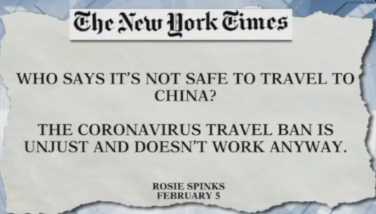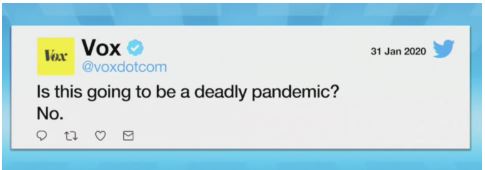Coronavirus deaths in the United States: Should the media be held responsible for misleading the public about their early coverage of coronavirus?

It’s all over the news, the death toll in the United States due to the coronavirus is higher than any other country in the world. Yes, but what many people are not talking about is that the U.S. population is also higher than most of Italy, Spain, France, and other countries with high number of coronavirus deaths. Many pointed out that the higher number of deaths was due to our slow response to social distancing guidelines. This fact is also supported by a piece from New York Times titled, “the timing of social distancing can have an enormous impact on death tolls.”
However, is it possible that there are other factors at play here? As we all know, the guidelines about social distancing did not start until late January or early February. No doubt, everyone would agree with New York Times story that social distancing can indeed prevent the spread of the deadly COVID-19 disease. Did mainstream media downplay the coronavirus risks during the early months while blaming others for the same thing? The other question is, when did we start practicing social distancing? And why didn’t we start early?
To answer this question, we need to understand how and where people get their news. For the most part, most Americans get their news from popular mainstream media like NY Times, Washington Post, ABC, CBS, NBC, CNN, MSNBC, Fox News, and their local affiliate stations. For tech savvy people, most go online to sites like VOX, BuzzFeed, Axios, Recode and many more. By the way, TechStartups is not the only site asking these questions? VOX just wrote a piece just two days ago titled, “What went wrong with the media’s coronavirus coverage?”
The point is, some of the media outlets knew their reporting probably misled the public and caused immense damage that they had to change their headlines. For example, Maimuna Majumder, an epidemiologist at Harvard Medical School, told BuzzFeed News on January 28 — in a story originally titled “Don’t Worry About The Coronavirus. Worry About The Flu” — that some worst-case projections about the disease’s velocity were “absolutely premature and hyperbolic.” However, BuzzFeed later changed its headline to this: “Here’s What We Do And Don’t Know About The Deadly Coronavirus Outbreak.”
Washington Post even went as far as blaming the government’ response to coronavirus. In a February 3 story titled, “Why we should be wary of an aggressive government response to coronavirus,” Washington Post said, “harsh measures tend to scapegoat already marginalized populations.”
Almost through the middle of the story, BuzzFeed said this: “Update: This story was originally published with a different headline comparing the effect of the coronavirus outbreak in the US to the flu. The headline, and the story, was based on information available in late January. Because the story is still being widely shared, we have decided to change the headline in order to reflect our current understanding of the pandemic. Here is the most recent BuzzFeed News coverage on the coronavirus.”
Anyway, let’s get back to the main point of the story. To get a good understanding of how media coverage of coronavirus could have impacted people’s behaviors during these early months, we scoured the internet for headlines from mainstream media during the months of January and February. Below are our findings, which showed the media probably did not get it right in the early months of the coronavirus outbreak.
February 21: In an article titled, “Racist attacks on Asians spreading faster than coronavirus in US,” CNN claimed “racist assaults and ignorant attacks against Asians” were spreading faster than the coronavirus itself. According to CNN’s “experts,” rampant ignorance and misinformation about coronavirus has led to racist and xenophobic attacks against anyone who looks East Asian.
February 18: The New York Times published a piece titled, “In Europe, Fear Spreads Faster Than the Coronavirus Itself.” The article claimed fear was spreading faster than the coronavirus in Europe. After 40 cases were confirmed, the New York Times decided to highlight the supposed “stigmatization” that came with having the coronavirus and how it hurt people’s feelings. Three weeks later, Italy shut down completely and thousands of people died.
February 5: In a piece titled, “Who Says It’s Not Safe to Travel to China?,” New York Times said this: “Coronavirus travel ban is unjust and doesn’t work anyway.” The author went on to say the following: “Respiratory infections, however, know no borders. The virus has spread regardless of extreme measures taken by governments around the world, which include the cancellation of flights, the shutting down of borders and the issuance of travel advisories usually reserved for conflict zones.”

February 3: In a story titled, “Why we should be wary of an aggressive government response to coronavirus,” Washington Post said, “harsh measures tend to scapegoat already marginalized populations.”
February 1: Washington Post wrote a piece titled: “Get a grippe, America. The flu is a much bigger threat than coronavirus, for now.”
January 31: Vox: This Isn’t A Deadly Pandemic. In a since deleted tweet Vox tweeted, “is [coronavirus] going to be a deadly pandemic? No.” Vox tweeted this on January 31, two days after the White House announced they were creating a coronavirus task force and would expand their travel ban to China.

January 31: In an article titled, “How our brains make coronavirus seem scarier than it is,” Washington Post said Coronavirus Isn’t So Scary. In a “perspective” article, retired Harvard professor David Ropeik wrote for the Washington Post how the cognitive biases in our brain make coronavirus seem scarier then it actually is.
January 29: Talking about flu instead of coronavirus, USA Today said this: “Something Far Deadlier Than The Wuhan Virus Lurks Near You,” USA Today, 1/29/20
January 28: BuzzFeed News wrote in a story originally titled “Don’t Worry About The Coronavirus. Worry About The Flu.” However, BuzzFeed later changed its headline to this: “Here’s What We Do And Don’t Know About The Deadly Coronavirus Outbreak.”




